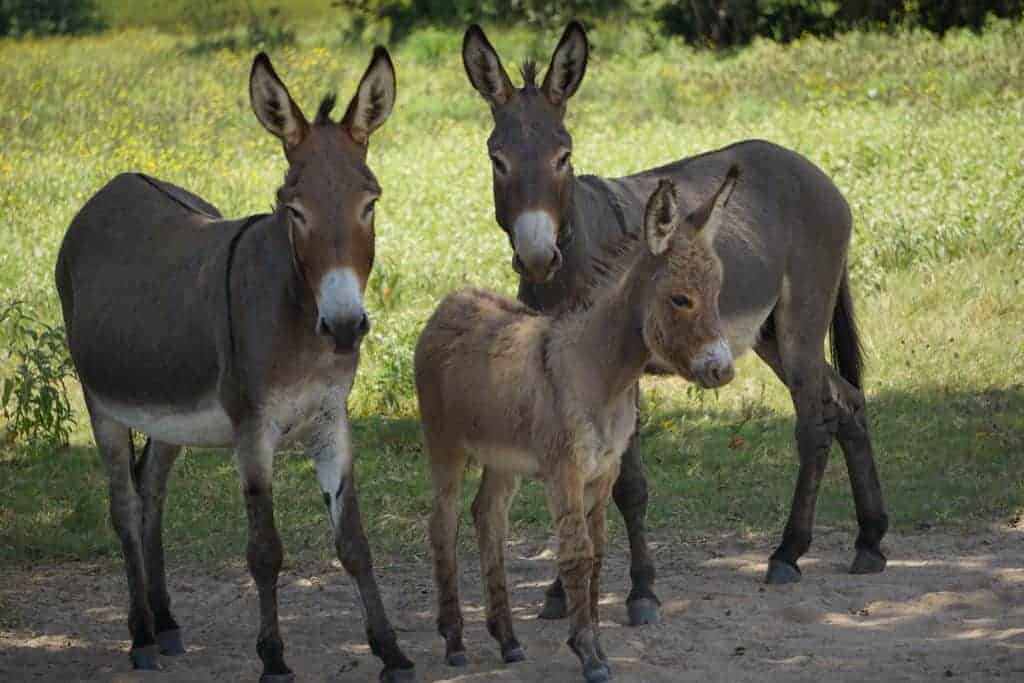Burro Buddies
Donkeys are wonderfully thoughtful, intelligent animals. Stubbornness is often associated with the donkey, but their seemingly-recalcitrant behavior is due more to their strong sense of self-preservation than sheer hard-headedness. In fact, people often mistake a donkey’s fear or uncertainty for stubbornness. When faced with a potential threat, donkeys are more likely to stand their ground than horses. However, this doesn’t mean they are not fearful. They simply have lower flight responses to novel or frightening situations and carefully consider the situation at hand, or hoof, as it may be. But how did these modern-day jacks (male donkeys) and jennies (female donkeys) come to be?
A History Lesson
Studies utilizing DNA sequencing suggest the modern domesticated donkey descended from wild asses in Northeast Africa beginning around 6,000 years ago. There are 2 separate species of wild asses, the African (Equus africanus) and the Asiatic branch (Equus hemious). While there are two subspecies in the African branch, the Somali wild ass (Equus africanus somaliensis) and the Nubian wild ass, (Equus africanus africanus), only the Nubian wild ass (Equus africanus africanus) is believed to be the ancestor of the modern domesticated donkey (Equus asinus) as we know them. Interestingly, recent genetic testing reveals that modern Nubian asses are genetically identical to ancient domesticatedAdapted over time (as by selective breeding) from a wild or natural state to life in close association with and to the benefit of humans donkeys. This indicates that modern Nubian wild asses may be descended from previously domesticated donkeys. Sadly, the Nubian wild ass and Somali wild ass are now critically endangered.
Domesticated donkeys can now be found all over the world. Donkeys were domesticated to produce meat, and milk, and as transport of both goods and humans. Around 2,000 years ago, donkeys were used to transport goods overland along the Silk Road, resulting in a variety of donkey breeds and their use in other regions such as Greece, the Middle East, and Italy. The Roman Army also used donkeys as pack animals and for agricultural purposes, bringing them to northern Europe. Spanish explorers and colonizers brought donkeys to South, Central, and North America.
The Old And New
The modern domesticated donkey differs from their historic counterparts in several ways. Domesticated donkeys are generally smaller than wild donkeys and have smaller, less sturdy foot bones. The Nubian wild ass has a light grey or fawn-colored coat. Somali wild asses have horizontal black stripes across their legs, much like a zebra’s markings. Domesticated donkeys come in many different colors (brown, white, grey, black, spotted) and vary in size, depending on how they have been bred. Standard donkeys are between 36-48 inches high from hoof to withers, while miniature donkeys (a separate breed originating from Sardinia and Sicily) stand no taller than 36 inches. On the other end of the spectrum is the largest donkey breed, the American Mammoth. They can weigh between 900-1200 pounds and stand at least 54 inches high, though many are even taller!
Challenges Facing Donkeys
Archaeologists have discovered ancient donkey burials and evidence of damaged spinal columns indicating the use of donkeys as pack animals. Today 95% of donkeys across the world continue to be used as work animals, mostly to transport materials or people in developing countries. These donkeys face numerous health issues, including lameness, malnourishment, sores, and parasites.
Another more recent threat to donkeys is a growing demand for their skins to produce a traditional Chinese medicine known as Ejiao. It is estimated that at least 1.8 million donkeys are killed for their skin every year to supply the demand for medicine and beauty products containing Ejiao. For hundreds of years, donkeys have been used for milk production in China, Pakistan, and Ethiopia. In Europe, the demand for donkey milk is increasing, bringing along with it a host of welfare concerns for the donkeys used in the industry. While donkeys in the United States exhibit only a fraction of the global population of donkeys, they experience unique challenges. It is estimated that there are nearly 15,000 feral donkeys living in the western United States. Considered an invasive species, their numbers present an issue for the ecosystems in which they are living. This has resulted in government-led donkey round-ups, cullings, and, for the lucky ones, adoption programs.
One challenge that spans continents and is especially relevant to sanctuaries is the practice of treating and caring for donkeys like horses. Donkeys are unique, even among other equids. Donkeys have different nutritional requirements from horses, and common care practices utilizing horse care guidelines have caused many donkeys harmThe infliction of mental, emotional, and/or physical pain, suffering, or loss. Harm can occur intentionally or unintentionally and directly or indirectly. Someone can intentionally cause direct harm (e.g., punitively cutting a sheep's skin while shearing them) or unintentionally cause direct harm (e.g., your hand slips while shearing a sheep, causing an accidental wound on their skin). Likewise, someone can intentionally cause indirect harm (e.g., selling socks made from a sanctuary resident's wool and encouraging folks who purchase them to buy more products made from the wool of farmed sheep) or unintentionally cause indirect harm (e.g., selling socks made from a sanctuary resident's wool, which inadvertently perpetuates the idea that it is ok to commodify sheep for their wool).. Taking time to learn about the unique needs of the donkey will help ensure happy, healthy donkeys!
SOURCES:
Out Of Africa: The Origin Of Donkeys | Genome News Network
The Domestication History Of Donkeys (Equus Asinus) | ThoughtCo.
American Mammoth Jackstock | Livestock Conservancy
Donkey Skin Trade | American Veterinary Medical Association
Causes Of Welfare Issues in Working Horses and Donkeys | The Brooke
Herd Area and Herd Management Area Statistics | Bureau For Land Management
About Donkeys I The Donkey Sanctuary
The Donkey In Human History: An Archaeological Perspective | Google Books
Dairy donkey: An Alternative Building Layout | Journal of Agricultural Engineering









